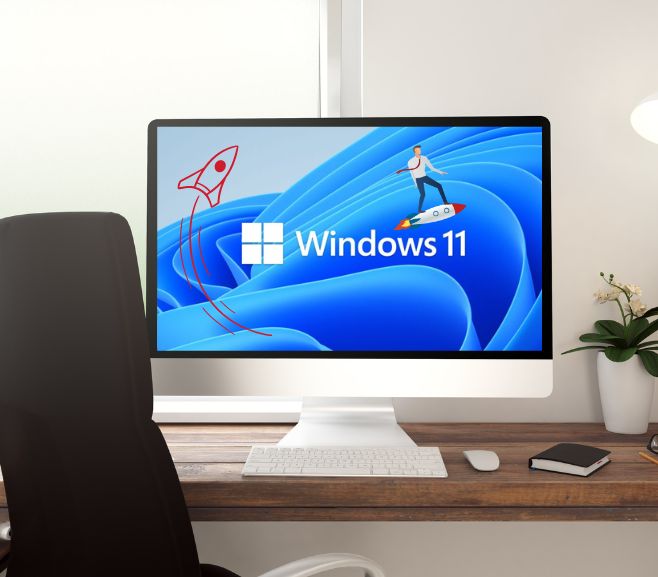Are you struggling with sluggish performance on your Windows 11 computer? If so, you’re not alone. Many users have reported slow boot times, laggy apps, and overall poor performance on Microsoft’s latest operating system. Fortunately, there are several things you can do to speed up Windows 11 and get better performance from your PC. In this article, we’ll share some tips and tricks that can help you optimize your system and get it running faster.
- Check for Updates
- Disable Startup Programs
- Uninstall Unnecessary Apps
- Disable Unnecessary Visual Effects
- Adjust Power Settings
- Use a Solid-State Drive
- Enable ReadyBoost
- Remove Malware and Viruses
- Clean Up Your Hard Drive
- Defragment Your Hard Drive
- Adjust Virtual Memory Settings
- Disable Unnecessary Services
- Disable Transparency Effects
- Adjust Display Settings
- Disable Unnecessary Animations

Check for Updates
One of the first things you should do when trying to speed up Windows 11 is to check for updates. Microsoft regularly releases updates to improve performance and fix bugs, so make sure your system is up to date. To check for updates, go to Settings > Windows Update and click on “Check for updates.” If any updates are available, install them.
Disable Startup Programs
Another way to speed up Windows 11 is to disable startup programs. Many apps and programs will automatically start when you turn on your computer, which can slow down the boot process. To disable startup programs, go to Task Manager > Startup and disable any programs that you don’t need to start automatically.
Uninstall Unnecessary Apps
If you have too many apps installed on your computer, it can slow down performance. Uninstall any apps that you don’t use or need. To uninstall an app, go to Settings > Apps > Apps & features and select the app you want to uninstall.
Disable Unnecessary Visual Effects
Windows 11 has several visual effects that can slow down performance. To disable them, go to Settings > System > Display and turn off “Animations in the taskbar” and “Transparency effects.”
Adjust Power Settings
Windows 11 has several power settings that can affect performance. If you’re not using your computer on battery power, select the “High performance” power plan. To do this, go to Settings > System > Power & battery and select “High performance” from the drop-down menu.
Use a Solid-State Drive
If your computer is still using a traditional hard drive, upgrading to a solid-state drive (SSD) can significantly improve performance. SSDs are much faster than traditional hard drives and can greatly reduce boot times and app loading times.
Enable ReadyBoost
If you don’t have an SSD, you can still improve performance by using ReadyBoost. ReadyBoost is a feature that allows you to use a USB flash drive or SD card as extra memory. To enable ReadyBoost, insert a flash drive or SD card, right-click on it in File Explorer, and select “Properties.” Go to the “ReadyBoost” tab and select “Use this device.”
Remove Malware and Viruses
Malware and viruses can slow down your computer and cause other performance issues. Make sure you have a good antivirus program installed and perform regular scans to detect and remove any malware or viruses.
Clean Up Your Hard Drive
A full hard drive can slow down performance. Delete any unnecessary files and folders, and run the Disk Cleanup utility to remove temporary files and other junk files. To run Disk Cleanup, go to File Explorer, right-click on your hard drive, and select “Properties.” Go to the “General” tab and click on the “Disk Cleanup” button.
Defragment Your Hard Drive
If you’re still using a traditional hard drive, defragmenting it can help improve performance. When files are saved on a hard drive, they can become fragmented, which means that parts of the file are saved in different places on the hard drive. This can slow down access times. To defragment your hard drive, go to File Explorer, right-click on your hard drive, and select “Properties.” Go to the “Tools” tab and click on “Optimize.”
Adjust Virtual Memory Settings
Virtual memory is a feature that allows your computer to use hard drive space as temporary memory. If your computer doesn’t have enough physical memory (RAM), it may use virtual memory, which can slow down performance. To adjust virtual memory settings, go to Settings > System > About and click on “Advanced system settings.” Go to the “Advanced” tab and click on “Settings” under “Performance.” Go to the “Advanced” tab again and click on “Change” under “Virtual memory.” You can then adjust the virtual memory settings.
Disable Unnecessary Services
Windows 11 has many background services that run automatically. Disabling unnecessary services can help improve performance. To disable services, go to Task Manager > Services and disable any services that you don’t need.
Read: How to Fix the Windows 11 Blue Screen of Death
Disable Transparency Effects
Transparency effects can slow down performance. To disable them, go to Settings > Personalization > Colors and turn off “Transparency effects.”
Adjust Display Settings
Adjusting display settings can also help improve performance. To adjust display settings, go to Settings > System > Display and lower the resolution and scale.
Disable Unnecessary Animations
Disabling unnecessary animations can also help improve performance. To disable animations, go to Settings > Ease of Access > Other options and turn off “Play animations in Windows.”
By following these tips and tricks, you can significantly improve the performance of your Windows 11 computer. From checking for updates to disabling unnecessary services, these steps can help you get more out of your PC. Keep in mind that some of these changes may affect the look and feel of Windows 11, but they can help make your computer faster and more responsive.




